How much does it cost? To receive your free estimate, click Estimate My Job button:
FEATURED SERVICE — Geothermal Heating and Cooling Contractor
Daniel Dean excavates and prepares your property for geothermal systems… for residential and commercial heating and cooling… for new constructions and existing property.
Residential Dirt (Site) Work

Factors for House Pad Location
It’s critical to choose the right location for your house. On smaller properties, there’s not a lot of wiggle room. Don’t let your choice of where to build the house deter a potential buyer when you’re ready to sell.
Factors, such as, do you want your house to be hidden, or totally visible from the street, or something in between. Leaving brush on the property sides can form a privacy barrier between you and your neighbor. There is an incredible feeling to be able to walk on your back porch with the privacy you want.
read moreBuild lines and valuable trees also come in to consideration. You may want to move your house forward 20 or 30 feet to save a really nice oak tree. Where you place your house will also greatly impact the existing natural drainage. You do not want to build your home in the bottom of a valley where water collects, or where water flows from one side of your property to the other and your house and long drive cuts off the flow of natural water shedding. If you don’t have a choice, then you have to plan how you’re going to reroute the water around your house. These are important decisions that you really need to know what you’re doing so you’re not creating a major impact on the drainage.
And with the torrential rain storms that we have around Houston, drainage is so incredibly important.
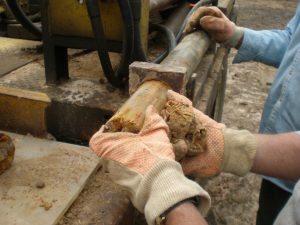 Soil Sampling and Bore Testing
Soil Sampling and Bore Testing
Boring is drilling a hole, tunnel or well in the earth. Our goal is to understand the ground. Almost all bore testing helps save site pad development. It can save you thousands. Bore testing helps in determining the type of foundations needed for a building or raised structure or underground structures.
read moreThere are two types of dirt testing: bore testing and compaction testing
During bore testing we typically drill holes of 10 feet, 15 feet, and 20 feet down where the proposed site pad will be built. This soil is taken to the lab to evaluates the types of soil, which determines how the foundation will be engineered.
Compaction testing occurs after Daniel Dean has placed and compacted the select fill. The select fill is spread evenly in lifts (layers) by a bulldozer and compressed with a vibratory compactor. A laboratory testing engineer will be on site and shoot it with a nuclear gauge to determine the compaction rate.
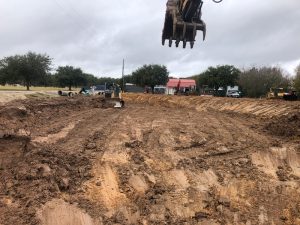 Pad Wet Sub-grade
Pad Wet Sub-grade
If the sub-grade (native soil) is wet underneath the pad, the select fill will not fully compact. There are a few different ways to fix wet sub-grade, but they are all expensive options:
- remove the wet sub-grade down to dry material and back fill with imported select fill
- mix lime / fly ash into the sub-grade to dry and harden it
- remove the wet sub grade at pad and at second nearby location; continue digging at second location to reach and extract dry sub-grade and refill the pad area before select fill is added.
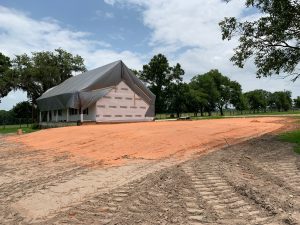 House Pad Construction
House Pad Construction
After the land clearing is complete and the pad location determined, it is important for all the trees, brush, stumps, roots and organics to be removed from that area.
read moreIt is standard procedure to strip away 6 inches of dirt, then import the select fill (a mixture of sand and clay) so that area can be built up to the finished elevation ready for the foundation. The select fill is repeatedly spread, rolled and compacted in lifts, or layers, of about 8 inches per layer to ensure complete compaction. Daniel Dean provides all testing documentation to validate and verify that the pad meets or exceeds the minimum compaction rate of 95%.
The pad is over-built by 5 feet on all sides and give it a 4 to 1 slope on the edges. Over-building also adds strength and integrity to the pad to prevent shifting and erosion.
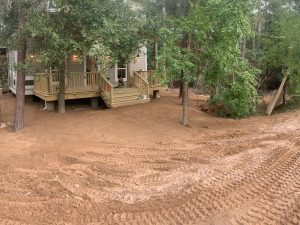 Final Grading
Final Grading
Final grading is the last part of the dirt work that is necessary. This makes the yard smooth, and most importantly, ensures that water drains away from the house and out of the yard.
read moreIn situations where the area around the house is flat, a lot of skill and laser grading the dirt is required to ensure water flows away from the house.
“It’s crazy to think that we often have to fix final grading around the house 10 or 15 or 20 years later because it wasn’t properly done in the beginning.”
Daniel Dean
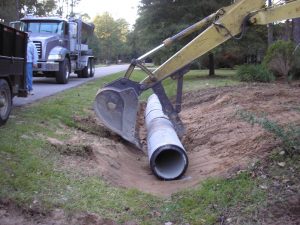
Culvert for Roadside Ditch
Culvert for roadside ditch is a pipe that is placed in the ditch that will allow a driveway to be built over it to allow access from road to property. After the pipe is installed, material is placed over the pipe as a filler to bring up the elevation to enable vehicles to travel across it.
read moreCulverts usually have some type of crushed rock or concrete as a top overlay, such as crushed concrete, crushed limestone, miller asphalt, laying hot mix asphalt or poured concrete.
Some counties or neighborhoods might require concrete pipe (RCP – Reinforced Concrete Product), but most will allow black plastic corrugated pipe (HDPE) to be used. Both are equally good. The concrete pipe requires stabilized sand to be used with it, and it cost more and is more labor intensive to install.
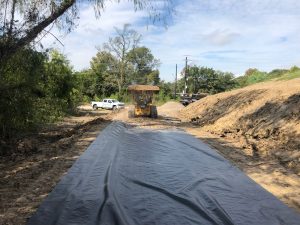 Driveway and Road Construction
Driveway and Road Construction
Daniel Dean builds driveways and roads using different types of surface materials and rocks. These include crushed limestone, crushed concrete, concrete wash, crushed granite or crushed asphalt.It is important to have the dirt placed correctly underneath the rock surface is applied.
read moreIf the subgrade is wet or soft, it doesn’t matter how much rock is placed. It will still not hold up. In the situation like this, it is best to remove the muddy material and back-fill with good clay in lifts (layers), or bring in lime or fly ash to mix into it to dry and harden the soil.
If water flow across your drive, a pipe will need to be installed underneath the drive so not to erode your drive material.
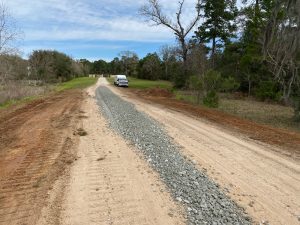 Driveway Repair
Driveway Repair
A driveway is used several times every day. A rough driveway wears down your vehicle and makes coming and going a little more stressful. If there is plenty of rock on the existing driveway, Daniel Dean can scrape it back-and-forth and wet it as we redistribute the gravel, then compact it.
read moreTo supplement your existing drive, we can add new crushed rock to fill in the areas, then blade it back-and-forth to mix them. Wetting the drive during this process is important for the crushed material to bond and hold.
Tip: Building a driveway or road at the same time as the house pad has several advantages:
- trucks are bringing the same materials anyway
- bulldozer and equipment is already set up on site and there are no extra mobilization costs
- trucks rolling in and out compacts the dirt
If a good base material is used, you can pour concrete or lay asphalt on top at a more convenient time. Options for a good base of crushed material include:
- concrete
- limestone
- asphalt
- granite
- iron ore
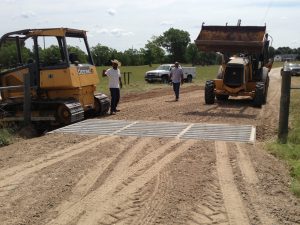 Cattle Guard
Cattle Guard
Having a cattle guard allows you to drive down your driveway or road and not have to open or close a gate and still keep horses or cattle on your property.
The depth of the cattle guard depends on local soil conditions, but generally the footers should be 12 inches deep and positioned to support the grill and disperse the full weight of crossing traffic. Typical dimensions are about 8 feet wide and usually 10 to 24 feet long, depending on your circumstances.
To receive your free estimate, click Estimate My Job button below:
Commercial Site Work

Commercial Building Pads
With any commercial building, the most important thing is its foundation, or pad. It’s critical that the soil a structure sits on is stable. A commercial building pad has to be properly prepared to prevent problems caused by uneven settling, erosion and flooding.
read moreA lot of the soil around Houston has a high content of clay, which is sensitive to moisture fluctuations. When water is added to clay it causes the soil to expand and heave upward, subjecting foundations to pressures from underneath. As opposed to if water is withdrawn, clay soils will contract, sometimes creating voids that leave portions of the foundations unsupported.
Depending on the type of soil and the surrounding elevation, there are several considerations to ensure a solid foundation. Sometimes it’s acceptable to remove the top 6 inches of soil because this is the organic soil that decomposes and causes voids in soil. Sometimes engineers require that 2-6 feet of soil is removed and back filled with compacted select fill. Sometimes it’s necessary to import lime or fly ash and mix it into soil to harden the soil.
It’s important to know the type of soil you will be building on. Ask Daniel Dean to evaluate the soil where your structure will be built.
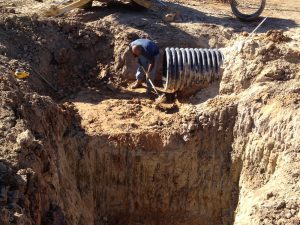 Underground Storm Drains and Systems
Underground Storm Drains and Systems
Daniel Dean installs minor or major storm drains and systems that are right for your business needs.
Commercial properties typically create more runoff per square foot than other land uses, mostly due to large areas of impervious surfaces such as roofs and parking lots.
read moreDuring a storm or downpour, this sudden accumulation of water has to go somewhere. Storm water runoff from paved surfaces can be directed to unlined ditches (sometimes called swales or bioswales) before flowing into the storm sewers, recharge basins or detention ponds. All commercial sites are required to maintain a storm water permit.
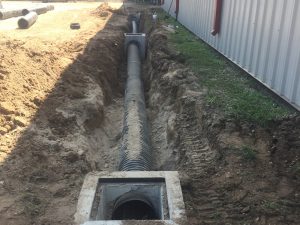 Installing a Storm Drain
Installing a Storm Drain
System
The purpose of the storm drain is to help prevent flooding by diverting rainwater off of the streets and other paved surfaces and into a natural body of water. Typically, corregated flexhose is attached to the down spouts on building to redirect the water. These flexhoses—often from multiple down spout— are networked into a larger pipe, which feed into a catch basin. As the catch basin receives storm water, trap debris entering the outlet pipe. All excess storm water from the piping network is discharged away from the business at an outfall location where it can permeate into the ground.
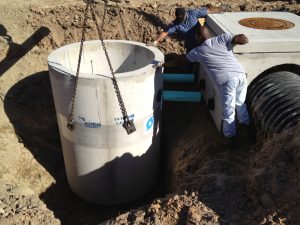 Installing a StormTrooper® System
Installing a StormTrooper® System
A StormTrooper removes sediments, trash and oil from storm-water runoff. To keep ditches and underground drainage in the right of ways from filling with dirt and sediment, the county requires devices, such as a Storm Trooper, to be installed. Plastic corrugated pipe is installed at specific elevations surrounded with stabilized sand in preparation for back filling or paving. Inlet boxes (or catch basins) are used as a junction for the water to outfall in a different location. A grate is placed on top of the box to allow water to flow into the basin, then to the StormTrooper. Runoff water circulates in the Storm Trooper, which has foil packs to collect oil and solvents. Dirt and sediment collect at the bottom, which is regularly cleaned out by a pump truck.
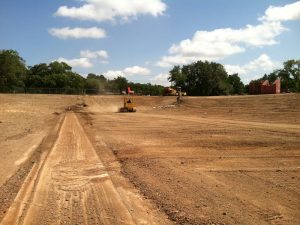 Detention and Retention Pond Construction
Detention and Retention Pond Construction
Two different kinds of ponds are used for flood control and storm water runoff treatment: wet ponds and dry ponds. Both function to settle suspended sediments and other solids typically present in storm water runoff.
read moreWet ponds are retention ponds. They have a permanent pool of water that fluctuates, depending on the amount of rain and runoff from the area. Maintaining a pool discourages re-suspension and keeps deposited sediments at the bottom of the holding area.
Detention ponds are more common in dryer, arid areas and serve as flood control. With our flat terrain and unpredictable rain, almost every area around Houston has or needs a detention pond. Detention ponds are cheaper than underground piping and usually stay dry. Their purpose is to slow down water flow and hold it for a short time. Urban areas rely on these detention ponds to reduce peak runoff rates from storms and prevent flood damage.
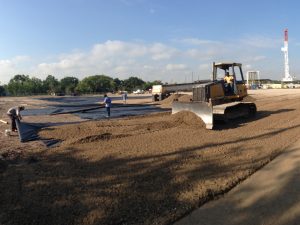 Laydown Yard Construction
Laydown Yard Construction
A laydown yard is an area outside where your stockpile of bulky materials, pipes, storage containers, construction equipment, etc. are stored until they need to be used. They are most common on construction sites, but other operations such as manufacturing or oil field operations have laydown yards as well.
read moreThe construction of a laydown yard is similar to building a drive or road, where a good foundation is important. Turnkey construction services such as land clearing, site grading, soil stabilization, geotextile fabric installation and drainage are provided by the professional services of Daniel Dean.
Depending on the leveling and condition of the area, your project may require all of these services. They are an essential to producing a safe area to work with. Without any of these options you risk losing your investment. Erosion, flooding, and loose land can be detrimental to the area.
The best way to build a lay-down yard is to scrape back the top soil, import in place lime fly ash or cement and mix it into the sub-base. This creates a hard surface for 8 to 10 inches of crushed rock, crushed concrete or crushed limestone to be added.
Before you place the crushed material, it is also important to make sure that the sub-base is graded so water can flow off the surface. Ideally, you would want to install an underground storm drainage system, providing you have the elevation.
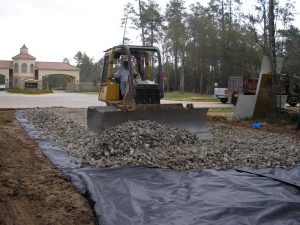 Construction Entrance
Construction Entrance
A construction entrance is normally built out of 3 x 5 rock. Because there are no fines in the rock, the truck tires do not collect mud and other material from the rocks. This is a standard procedure for a project that has an Storm Water Pollution Prevention Plan (SWPPP), a document that outlines how a construction project will minimize storm water pollution.
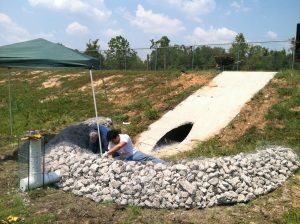 Water Filtration Systems (Rock Filter Dam)
Water Filtration Systems (Rock Filter Dam)
Another method to filter dirty water is to install a rock filter damn. This is stone embankment designed to capture coarser sediment. They are commonly used near drainage areas that are susceptible to large amount of erosion. The rocks on the dam catch loose sediment and can be easily cleaned periodically.
read moreConsiderations should always be made when constructing rock filter dams. You don’t want the impounded water behind the dam to runoff into other locations. This prevents the purpose of having the dam for sediment catching purposes altogether.
Over topping, or overflow of an embankment dam beyond its spillway capacity, will result in failure. The erosion of the dam’s material by over topping runoff will remove masses of material whose weight holds the dam in place. This can lead to a very dangerous dam break and could leave you with runoff and flooding.
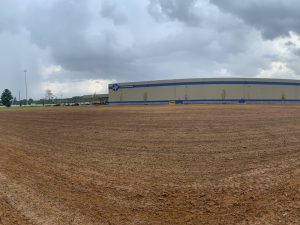 Commercial Final Grading
Commercial Final Grading
There is very little difference between commercial final grading and residential final grading. Again, if the area around the structure is flat, a lot of skill and laser grading the dirt is required to ensure water flows away from the building. Then, simply back-fill the dirt up against the concrete.
To receive your free estimate, click Estimate My Job button below:
Geothermal Excavation Contractor
Why use Daniel Dean to excavate your geothermal trench or pit?
- Equipment. Exactly right sized equipment for each job, saving machine hours and labor and keeping your costs as low as possible
- Experience. With more than 30 years in dirt work excavation, Daniel Dean has seen it all: poor subsoil, such as deadpan; high water levels; digging on a slope prone to cave-in; bedrock. Recognizing and understanding how to work with, or around, these issues are only gained from experience. (Soils with a high water content and high bulk density, such as wet clay, are the best conductors and require many less ground loops compared to dry sand.)
- Trust. Daniel Dean built the business “through hard work, being honest and looking after the customer.” Today, Daniel Dean is recognized as the property development industry expert.
How much does it cost to install a horizontal closed-loop geothermal system?
To receive your free estimate, click Estimate My Job button above, or call 281-356-DIRT.
read moreWhat is Geothermal Heating and Cooling?
A geothermal heating and cooling system is an energy-efficient system that uses the natural ground temperature to warm or cool your home or business. It has three main parts:
- the air handling system to transfer the air
- the groundwater heat exchanger to take heat from the ground or back into the earth to cool
- and the geothermal loop that moves heat between the air handling system and the exchanger.
Types of Geothermal Loops
Closed Loop Geothermal System
Closed loop systems can be either horizontal or vertical plastic tubing underground or in a nearby lake or pond. Water and usually antifreeze are circulated in a closed system.
Open Loop Geothermal System
These geothermal systems are only an option if there’s plenty of clean, fresh water nearby, typically a well water or a lake on the property. After the water leaves the home, it’s expelled through a discharge well or suitable drainage system.
Types of Geothermal Systems
Daniel Dean installs Horizontal Geothermal Systems
A horizontal system typically is a closed loop where the fluid in pipes is recycled. Pipes are laid either in parallel rows or in a slinky loops in a trench (or multiple trenches) or a pit, approximately 5-10 feet deep, depending on soil conditions. Multiple trenches can be 100 feet long x 8 feet wide, whereas a pit is typically 50 x 100 feet. Trench area requires about 9000 feet of cleared land. Either method offers the most economical geothermal option for new homes or buildings, with the only requirements being lots of available land and the optimum kind of soil.
Vertical Geothermal Systems
A vertical geothermal system uses holes about 6-8 inches wide and drilling 200 to 400 feet deep to insert pipes for a closed loop system. If drilling for multiple pipes, about 20 feet of separation between bore holes is required. Vertical geothermal systems are generally more expensive than horizontal systems, but require less pipe and less area, which make them more ideal for suburbs.
How a Geothermal System Works
After a geothermal system is installed, a heat pump, usually located in an attic, garage or utility closet, circulates liquid through pipes into the ground. These pipes absorb the temperature that is distributed into the ground from the sun. The liquid in the loops circulates back up to the geothermal heat pump to heats or cools your home. In the winter, the heat from the liquid is extracted and distributed around the home. In the summer, heat is taken from the home into the liquid which carries it into the ground to cool.
Because of how a geothermal heating and cooling system works, it doesn’t require fossil fuels or a lot of electricity, it is environmentally friendly. It’s recognized by the United States Environmental Protection Agency (EPA) as a clean, renewable source of energy.
Tax Credits
The federal tax credit initially allowed homeowners to claim 30% of the amount they spent on purchasing and installing a geothermal heat pump system. The tax credit currently stands at 26% throughout 2021 and 2022, before decreasing to 22% in 2023.
Homeowners who install geothermal can get the tax credit simply by filling out a form declaring the amount you spent when you file your federal income taxes. As long as your system is up and running by the end of 2022, you can claim the 26% from your federal income taxes.
It’s an incredible advantage and can significantly reduce the cost of the system overall. There’s no limit to the value of the tax credit. As long as you still own the house where the system is installed, you can claim the true percentage based on the year you installed the system.
See current rules on tax credits at https://www.irs.gov/instructions/i5695.
Is a Geothermal System Efficient for Houston
Shared from https://www.city-data.com/forum/houston/138979-geothermal-heating-cooling-systems-common-houston.html.
“Let me clear all this up. I am a geothermal installer in Houston and yes it works well, and hundreds of systems are in use. Efficiency is about 30-40 SEER, about double the best conventional systems. Heating costs about 1/4 of gas heat costs. Ground temp here is about 72 degrees year round. This means we do not need to use antifreeze in the system. Drilling loops avg 250-300 ft each per ton, and drilling is not tough here. Cost is higher than conventional initially, but payback is in about 3-4 years. These systems are more common in Dallas and Austin, just because they are being pushed there more by manufacturers. Now that those markets are set, Houston is next. An investment that pays for itself many times over. In a 20 yr period. a typical 4 ton system will save over $70,000 in utilities.”
